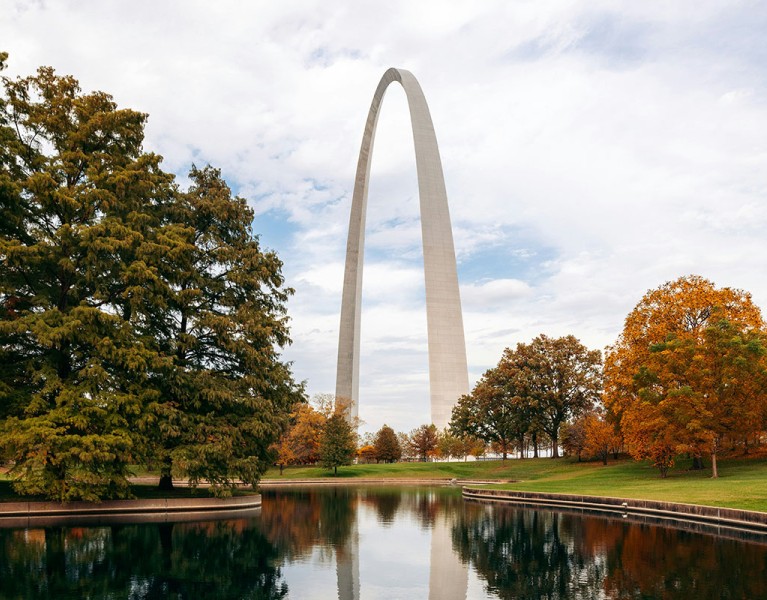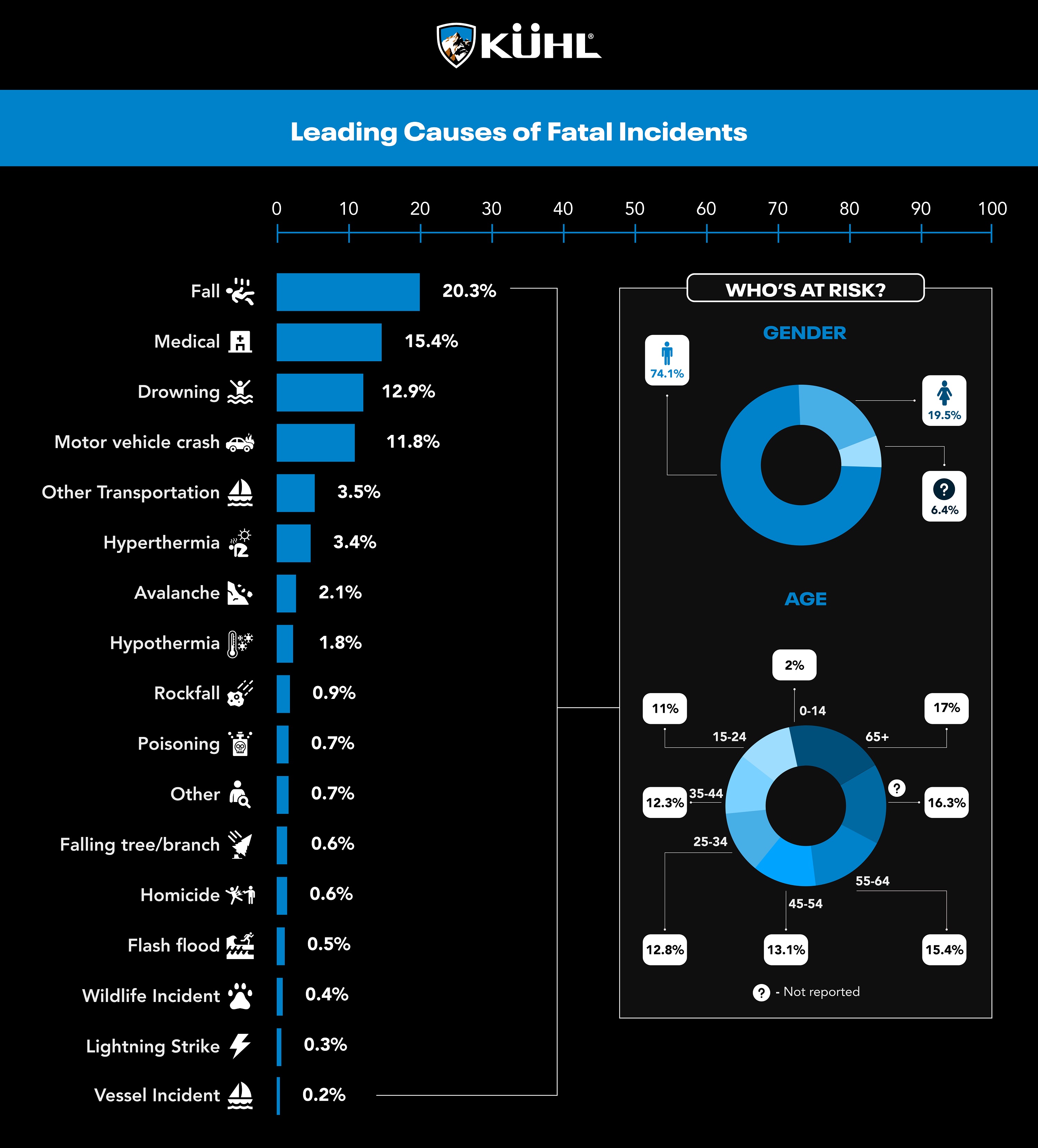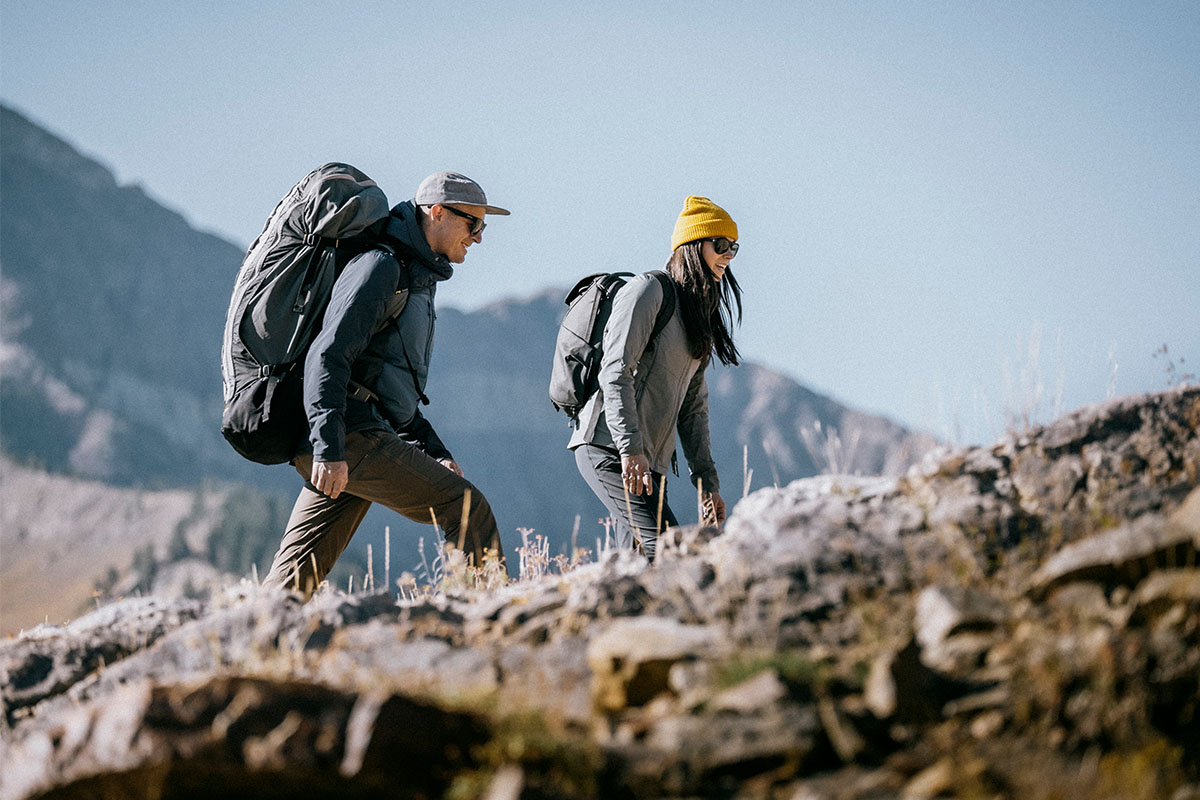- 1. What Are the Safest and Most Dangerous National Parks?
- 1.1. Who’s at Risk?
- 2. Hiking and Camping Safety: Putting Things in Perspective
- 2.1. You are safer in a National Park than…
- 2.2. Your chances of a fatal incident in a National Park are lower than you…
- 3. How to Stay Safe While Hiking and Camping
- 4. Methodology
- 5. Conclusion

U.S. National Parks Safety Index
Table of Contents [Show]
More than 300 million Americans visited our National Parks last year, and while this staggering number underscores their rising popularity, it also comes hand-in-hand with the possible risks involved. But how big of a risk is it?
To answer this question, we conducted an in-depth analysis of America’s national parks to determine the safest and, by contrast, the 'most dangerous.' This research aims to offer peace of mind to even the most cautious adventurers by highlighting the high safety numbers of our national parks.
We’ll delve into the specifics of how we got those numbers later in the article, but first, let’s take a look at the results:
What Are the Safest and Most Dangerous National Parks?
The top five parks, including Gateway Arch National Park in Missouri and Petrified Forest National Park in Arizona, scored highly on the safety scale due to their low numbers of missing persons and fatalities, minimal trail closures, and adequate ranger presence. While it's expected to find Gateway Arch National Park at the top due to its central city location, the other national parks on the list might be a surprise.
Consequently, the bottom five parks, such as Grand Canyon National Park in Arizona and Wrangell-St. Elias, in Alaska, scored highly on the danger scale due to a higher number of search and rescue missions, higher incidents of trail closures, and fatal incident rates.

The complete list of safest and most dangerous national parks.
While the rankings suggest a certain level of peril in the lower-scoring parks, it’s crucial to interpret 'danger' as indicative of higher risk exposure rather than inherent unsafety. This leads us to an important question:
Who’s at Risk?
Looking at the shadow side of the data, we wanted to know the leading causes of fatal incidents and the risk groups.
The numbers suggest that falls, claiming 20.3% of lives, emerge as the leading cause, followed closely by medical issues and drowning, accounting for 15.4% and 12.9%, respectively. Motor vehicle crashes also represent significant risks.
A striking aspect of these statistics is the gender disparity: males are overwhelmingly more likely to be victims, with a staggering 74.1% of fatalities compared to 19.5% for females. Age-wise, the elderly (65 and over) face considerable risks, but the danger spans all age groups, with those between 55 and 64 and 45 to 54 also significantly affected.
Despite the risks associated with exploring the outdoors, the numbers from our research imply that such incidents are, fortunately, more of an exception than the norm.

Hiking and Camping Safety: Putting Things in Perspective
According to our research, the average odds of a fatal incident in national parks are about 1 in 664,099 visitors. That is incredibly low, so much so that...
You are safer in a National Park than…
Walking Down the Street
The odds of a pedestrian dying in a traffic crash are 1 in 485, according to the National Safety Council. Hiking in a National Park usually presents fewer risks than going to your local coffee shop.
Climbing Ladders
Fatal falls from ladders happen with odds of about 1 in 680, according to the National Safety Council – again. Climbing a ladder in your backyard can be more dangerous than climbing a rock in the backcountry.
Eating a Meal
The odds of choking to death on food are approximately 1 in 2,659, according to Statista. This means that enjoying a meal is more hazardous than exploring national parklands. What if you were to eat a meal in a National Park? Hm…
Your chances of a fatal incident in a National Park are lower than you…
Having More Than 10 Fingers or Toes
According to the National Center for Biotechnology Information, the odds of being born with extra fingers or toes (polydactyly) are about 1 in 700-1000. So, statistically speaking, you’re more likely to have an extra digit to count the number of safe trips to National Parks.
Living to 100 Years Old
In the U.S., the odds of living to be 100 years old are approximately 1 in 3,407. You're more likely to join the 1% centenarian club than to face the Grim Reaper in a National Park.
Seeing National Parks From Space
According to NASA, the odds of being selected to train as an astronaut are around 1 in 1,200 for qualified applicants. Looking at the American wilderness from the Earth’s orbit might be more within your grasp than becoming a part of its statistics.

How to Stay Safe While Hiking and Camping
While the likelihood of facing danger in the National Parks is remarkably low, understanding the safety measures is still considered good practice. By taking these simple precautions, visitors can ensure their outdoor experiences remain thrilling, only in a positive way.
- Planning is Everything: Before you head out, check your national park's website. Go to 'Plan Your Visit' and look for ‘Find a Park’. Then select the State you want to visit and browse from the list of national parks. After finding the one that looks the most interesting to you, click on it. All current alerts and weather conditions will be displayed at the very top of the page, below the header.
- Weather Watch: Outdoor weather can be fickle. Use park webcams to get a real-time view of what you’re walking into. Pack for all scenarios!
- Stay on Marked Trails: Sticking to designated paths and trails is key for your safety. Venturing off-trail can lead to unexpected hazards and increases your chances of getting lost. Plus, staying on the trail helps protect the park's natural habitat.
- Gear Up: The right gear can make or break your trip. This isn’t just about comfort, it’s about safety. Think communication devices, suitable outdoor clothing, and enough food and water.
- Stay in Your Comfort Zone: Pushing your limits is tempting, but knowing your physical and mental boundaries is crucial for outdoor safety. Overconfidence can make a difference between a successful hiking trip and one gone wrong.
- Listen to the Pros: Park staff are there to help. Their advice is invaluable and can steer you clear of trouble.
- Emergency Prep: Have an emergency plan. Know the nearest medical facilities and basic first aid, and have a way to call for help. It’s better to have it and not need it than need it and not have it.
- Leave No Trace: Don't litter. Keep our beautiful parks clean! Remember to pack out what you pack in, and leave nature better than you found it. The future adventurous you will be thankful.
Methodology
Our research began with compiling a comprehensive list of 63 National Parks across the United States. We gathered information on the key safety indicators for each park from two primary resources: the National Park Service website and Google Maps.
- Total Deaths (2007-2023): The mortality data recorded in each park over these 16 years were compiled. This data offers insight into these environments' overall safety and potential hazards.
- Number of Missing Persons: We reviewed records of cold cases in each park from 2007 to 2023. This metric is a crucial indicator of potential risks within the park boundaries.
- Search and Rescue Missions (2013-2020): The frequency and scale of search and rescue operations conducted between 2013 and 2020 were evaluated. This measure indicates the frequency and severity of emergencies in the parks.
- Visitor Statistics (2007-2022): We analyzed the number of visitors to each park over 15 years. This helped us understand the scale of human activity in these parks and provided context to other safety metrics.
- Trail Closures, Alerts, and Cautions due to Animal Presence: We assessed the frequency of trail closures and the issuance of alerts and cautions due to potentially dangerous wildlife. This factor is key in assessing the risk posed by animal encounters. This data is accurate as of 24/10/2023.
- Number of Park Rangers: We utilized the U.S. Department of the Interior database to ascertain the number of park ranger employees at each National Park. While we could obtain exact figures for some parks directly, for others where such specific data was unavailable, we turned our attention to the ranger staffing levels of the nearest cities. This approach helped fill in the gaps, ensuring a more complete picture. A higher number of rangers can imply better surveillance, faster emergency response times, and improved overall visitor safety. These figures don’t include the number of volunteer park rangers.
- Proximity to Hospitals: Each park was evaluated for the presence of a hospital within a one-hour travel radius by car that operates 24 hours a day.
After compiling all the collected data, we averaged the numbers. We used the linear scaling formula to get the normalized scores for each national park for six out of seven key indicators.
Proximity to hospitals was not normalized but was included as a binary (yes/no) factor in the final rating, reflecting immediate medical care availability in emergencies.
Each indicator was then assigned a different weight score that impacted the final results of our analysis.
- Number of Missing Persons - 0.05
- Total Deaths - 0.50
- Visitor Statistics - 0.00
- Search and Rescue Missions - 0.20
- Trail Closures, Alerts, and Cautions due to Animal Presence - 0.05
- Number of Park Rangers - 0.05
- Proximity to Hospitals - 0.15
Then, we sorted the results by the final score, and that was it! You can see the complete list of national parks and all the data gathered here.
Would you weigh these indicators differently? Let us know in the comments.
Conclusion
It’s important to underline that there is nothing inherently dangerous about America’s national parks. The research has clarified that visiting national parks is exceptionally safe with proper preparation and respect for park guidelines. The perceived risks of these wilderness areas often stem from unpredictable natural elements rather than the parks.
This reassurance is backed by the low incident rates relative to the millions who visit each year, underscoring the National Park Service's commitment to visitor safety and the success of its conservation efforts.
So, dear adventurers, we can take solace in the splendors of America’s national parks, which can be enjoyed with peace of mind.
Research done by Andreea Anton.
Data analyzed by Oded Gross.
Written by Ivan Slovic.
Featured image by Andy Feliciotti.


